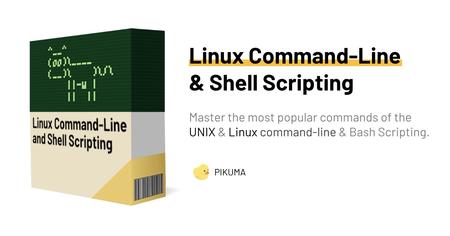English | MP4 | AVC 1920×1080 | AAC 44KHz 2ch | 58 Lessons (7h 56m) | 1.69 GB
Learn important OS concepts by mastering the most popular commands of the Linux command-line and Shell Scripting
This course is a comprehensive immersion into the command-line of Linux and other UNIX-like systems. We’ll learn the most popular shell tools and introduce concepts of Operating System theory that became popular with the UNIX OS.
We’ll also discuss other important development tools that we can use with Linux, and learn how to write shell scripts that can be used to to automate system tasks.
The tools you’ll need
You’ll need either a Virtual Machine to install Linux or a physical machine that can be partitioned to run a Linux distribution natively.
We’ll use a lightweight Linux distribution called Lubuntu and the Oracle VirtualBox Virtual Machine. All tools are cross-platform, so you can follow along on either Windows or macOS.
Is this course for you?
This course has no prerequisites and it’s designed to be as beginner-friendly as possible. We’ll start by understanding the history and the evolution of UNIX-like systems, and proceed to cover the most popular tools of the Linux command-line.
We will also try to be as portable as possible. All the commands we’ll learn should work with any Linux distribution and any other UNIX-like system (OpenBSD, FreeBSD, and macOS).
This course was designed with programmers in mind. Therefore, we will not be covering advanced Linux tools for networking, infrastructure, or system administration.
Table of Contents
1 Motivations and Learning Outcomes
2 How to Take this Course
3 Do All Computers Need an Operating System
4 The Evolution of UNIX
5 The Birth of Linux
6 Downloading Linux
7 Installing Linux
8 System Login
9 Navigating Files and Directories
10 Hidden Files
11 Viewing Contents of a Text File
12 Editing Text Files
13 File Globbing and Wildcards
14 Copying and Moving Files
15 Working With the Space Character
16 Removing Files and Folders
17 Putting It All Together
18 The Root Folder
19 Important System Folders
20 Working With Different Shell Options
21 Working With Find and Grep
22 Visualizing Operating System Processes
23 Killing Processes
24 Output Redirection
25 Input Redirection
26 The Pipe Operator
27 UNIX Common Ground
28 Adding Users
29 File Permissions
30 Executing Files
31 Environment Variables
32 Visualizing Environment Variables
33 RC Files
34 Working With a Package Manager
35 Popular UNIX Text Editors
36 Understanding System Calls
37 Popular Shell Utilities
38 What Is a Shell Script
39 Writing and Executing Shell Scripts
40 Working With Variables
41 Numerical Expressions
42 Script Special Variables
43 Tests and Conditional Statements
44 Example of String Test
45 For Loops
46 While Loops
47 Secure Shell and Daemons
48 Scheduling Tasks with Cron
49 Awk and Sed
50 Checking Filesystem Available Space
51 Functions
52 Linux Development Tools
53 Compiling with GCC
54 Debugging with GDB
55 Building with Make
56 Installing from Source
57 Popular Scripting Languages
58 Conclusion and Next Steps
Resolve the captcha to access the links!
